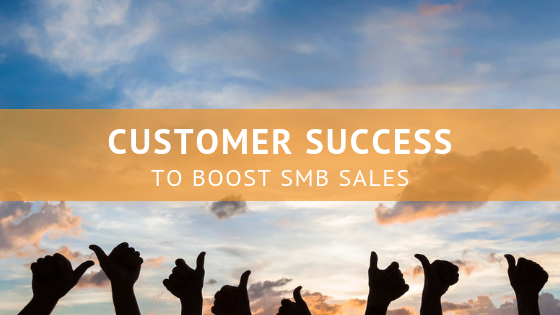Happy customers are your best salespeople. In any SMB sales initiative, part of your mission is to build customer loyalty, not only so those customers will come back to buy more but so they will also serve as brand evangelists. If you can build customer trust and engender loyalty, then that customer will advocate for you. What’s more, keeping happy customers is one-fifth the cost of acquiring new ones.
For every happy customer, you are likely to get nine referrals, but for every unhappy customer, you will get 29 negative reports. That is why it’s vital to promote customer success. In the new age of the customer, where customers have control over their business relationships thanks to software and self-service portals, you have to adapt new customer relations strategies in order to maintain customer success and scale your business. New pricing models with subscription, bundled, and tiered pricing are also changing the nature of the customer relationship. We are long past the days when closing the deal was the only objective. Maintaining ongoing relationships that engender customer success reduces customer churn, encourages positive advocates for your product, and gives you an opportunity to cross-sell and upsell in order to deepen the customer relationship.
However, to promote customer loyalty and boost SMB sales, you need a well-crafted customer success program to improves customer happiness.
Prioritizing Your Customer Engagement Strategy
Lasting customer relationships don’t just happen because you close the deal. You need a customer engagement strategy. And although all SMBs are important to your business, not all SMB sales are equal contributors to your overall success.
Start by prioritizing your SMB customers. The strategic accounts that promise a higher lifetime value should be designated as high-touch accounts, requiring more one-to-one interaction and personal attention. Those customers that are less likely to increase sales value over time require attention, but it’s not cost-effective to provide the same level of VIP service. The trick is to use digital and nuanced touch strategies to make those smaller customers feel important without turning your sales ROI upside down.
Rules for tiering will depend on your business model. You may want to prioritize your SMB customers based on the size of their purchase or their number of licenses. You may want to favor smaller SMB sales that have bigger potential over the life of the engagement. Whatever your go-to market strategy, rank your SMB sales in terms of annual recurring revenue and the post-sales support cost per customer.
Be sure to identify at-risk customers as part of your segmentation. Customers may be at risk because of financial difficulties, market conditions, poor customer service, or a host of other causes. If you segment your customers into tiers by overall value and potential value, it’s easier to allocate teams to address at-risk customers’ problems.
Automating Customer Relations
SMBs account for 99.7 percent of all businesses in the United States, but they may only make up a small segment of your total customers. If they promise less revenue, it’s not cost-effective to give them the same high-touch approach as top-tier customers. Instead, you can promote better customer service for these SMB accounts with automation:
Automate Regular Touch Points: Maintain ongoing communications with customers by programming touch points into the customer lifecycle. Using your CRM software for email automation is a common strategy. You can schedule a series of onboarding messages for new customers with helpful product tips and suggestions. To maintain the relationship, schedule regular newsletters, special offers, and other messages. You also can schedule a series of renewal messages prior to expiration of a subscription or warranty. These kinds of custom emails can be highly effective, and you can always alert a sales rep to intervene when needed.
Self-Help Platforms: Statistics show that 75 percent of customers see self-help as a convenient customer service approach. Providing detailed online manuals, FAQs, and other resources makes it easier for customers to answer their own questions. Analytics will reveal areas where customers are having the most difficulty or what generates the most questions, and you can improve those self-help areas or even be proactive in suggesting resources to address those issues.
Web-Based Training: Providing online training services is a cost-effective way to provide interactive customer support, and even cross-sell and upsell SMB customers. Customers can walk through the basic use cases or applications for a product, and even explore additional products or upgrades. Online chat has become an easy and popular way to provide real-time support without the need for dedicated personnel.
Of course, even with automation tools you still need a personal touch. Customers need to feel that you care for them and their needs. You need customers to feel nurtured and that you care about their needs, not just their money. Every customer needs to be valued, and showing that value enhances the customer experience. Don’t rely solely on automated systems. Establishing a relationship with customers through one-to-one, human contact will help you better understand customer needs and concerns, and it will make it easier to keep them as customers.
Ultimately, the sales team has a variety of tools at their disposal to promote SMB sales success and make SMB customers feel they are receiving top-level service. Sales reps are armed with CRM software, online tracking, analytics, surveys, and other tools, so they know more about their customers than ever before. There is no reason that they can’t develop a personalized customer relations strategy that nurtures customer interaction and trust.
If scaling SMB sales support is your concern, you can always bring in outside experts. Many companies find it challenging to scale their sales programs and maintain positive, proactive customer success programs. Rather than trying to scale by adding more staff, smart companies are outsourcing their inside sales by bringing on sales partners who can close new business and nurture customer success throughout the lifecycle of an engagement. We can show you how to improve your customer relations program and make the most of customer successes across your organization.








